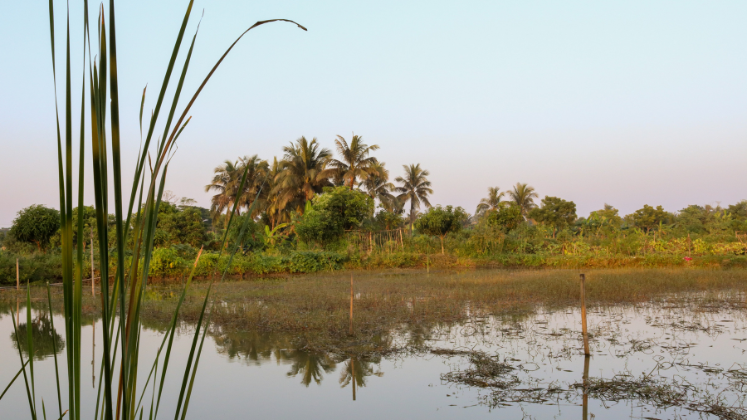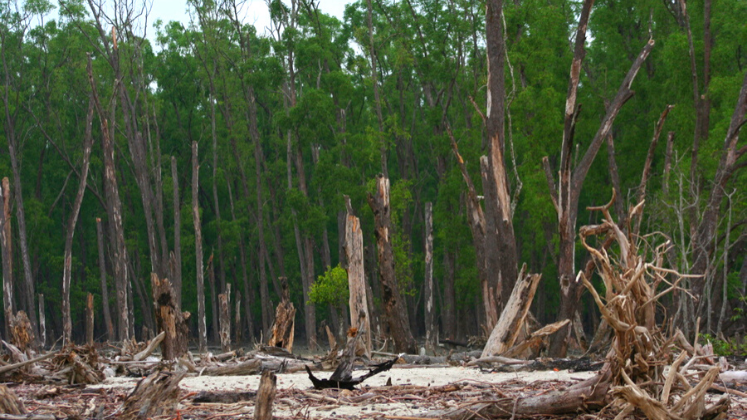To mark the start of COP27, Nikhil Deb reviews Threatening Dystopias by Kasia Paprocki, which explores climate change adaptation in the Khulna region of Bangladesh, a place extremely vulnerable to the threats posed by the climate crisis. This study deserves wide acclaim for its refreshing take on how the ideologies surrounding climate change and climate victims today reproduce and intensify rural dispossession.
If you are interested in this book review, you can listen to a podcast of the launch of Threatening Dystopias, recorded at LSE on 13 October 2022.
Threatening Dystopias: The Global Politics of Climate Change Adaptation in Bangladesh. Kasia Paprocki. Cornell University Press. 2021.
 Kasia Paprocki’s Threatening Dystopias offers a revealing political ecological analysis of climate change adaption in the southwestern Khulna region of Bangladesh, a place extremely vulnerable to threats posed by the climate crisis. Although experimentation and dispossession are common themes in critical scholarly analyses of development, perhaps no single place is a more apt example than these climate-vulnerable coastal regions of Bangladesh. Here, powerful actors have found the export-oriented shrimp industry to be the most profitable for Bangladesh, and they have since orchestrated the shift from rice agriculture to shrimp aquaculture. Among many fallouts of shrimp aquaculture is that land is too saline and too worn down to be used for traditional farming, limiting Bangladesh’s future appeal to global consumers.
Kasia Paprocki’s Threatening Dystopias offers a revealing political ecological analysis of climate change adaption in the southwestern Khulna region of Bangladesh, a place extremely vulnerable to threats posed by the climate crisis. Although experimentation and dispossession are common themes in critical scholarly analyses of development, perhaps no single place is a more apt example than these climate-vulnerable coastal regions of Bangladesh. Here, powerful actors have found the export-oriented shrimp industry to be the most profitable for Bangladesh, and they have since orchestrated the shift from rice agriculture to shrimp aquaculture. Among many fallouts of shrimp aquaculture is that land is too saline and too worn down to be used for traditional farming, limiting Bangladesh’s future appeal to global consumers.
Paprocki writes with great eloquence and weaves together climate crisis, adaptation politics, sociopolitical history, agrarian transformation and countermovement in a way that effectively links concrete and local dynamics with the flow of global capital. The author outlines the essential components of what she calls an ‘adaptation regime’ in Bangladesh, a configuration of power governing the landscape as a possible intervention against the risks of climate change (7). Throughout the book, Paprocki discusses how Bangladesh’s sociopolitical history was formed through a crucible of colonialism, development projects and now climate change and the adaptation regime, which involves multiple state players on a national and international level as well as other development, research, media and science institutions.

Image Credit: Photo by Mahfuz Shaikh on Unsplash
In Chapter One, Paprocki illuminates the history of recent interventions in the face of climate change, discussing some critical historical processes through which the adaptation regime has been advanced. She presents an engaging description of the ‘prehistories of climate dystopia’, beginning with how the coastal region of Bangladesh, mainly the Sundarban mangrove forest, a UNESCO world heritage site, produced intense fascination and anxiety in the West. Tracing these dynamics to the colonial period is imperative because colonial powers considered ‘other’ societies primitive and vulnerable, believing they were doing them a favour when they implemented their own methods of engineering colonised nations. Specifically, the fluidity of the land of Sundarban was seen as both a threat and an opportunity by the British, who experimented in the physical and legal engineering of the region’s resources.
The socio-ecological history presented in Chapter One is a perfect segue into the next, and perhaps the most important, chapter of the book, which opens and ends with the Paris climate conference in 2015. It describes how development practitioners, who state they want to see a structural transformation of economies in climate-risk counties such as Bangladesh, are the same people who encourage the adaptation regime’s interrelated processes.
In Chapter Two, ‘Threatening Dystopias’, Paprocki lays out how powerful entities use imagination, experimentation and dispossession to prime the landscape and its inhabitants for mediation in anticipation of a possible climate crisis. The adaptation regime imagines Bangladesh’s southwest region as a doomed land not worth saving (and the people living there as only ‘kept alive’), already dystopic and inundated with rising sea levels and dangerous storms.
Framing climate change as an essential and dire part of the future gives the regime reason to use this region as an experimental laboratory. The World Bank has a map of Bangladesh’s coast with some areas considered ‘claimed’ for projects and others ‘available’, a mindset shockingly reminiscent of the colonial scramble for Africa (see James Goldsmith, 1994) or the division of Bengal during India’s independence (see Joya Chatterji, 2002).
Paradoxically, adaptation strategies developed by people living in rural Khulna do not appear in inventories of experimentation. Instead, the top-down adaptation activities that use the area as an ‘adaptation laboratory’ encourage agrarian dispossession by directing and stifling the locals’ production and adaptation strategies. It quickly becomes apparent that the ‘growth-centered’ approach has more to do with creating an experimental lab that converts the threat of an ecological crisis brought on by climate change into opportunities for export-driven economic growth than it does with the promise of any specific intervention.
To further highlight how the regime has permeated an imagination of Bangladesh as a ‘ground zero’ for climate change, experiments in development interventions and the dispossession of rural residents, Chapters Three and Four together underscore how uncertainty about climate change is produced and mobilised. While Chapter Three brings into focus how the politics of uncertainty is embedded in the adaptation regime and circulates among the actors in power, Chapter Four addresses the ways in which such uncertainty around climate change is employed to intervene in the region. Production of uncertainty over environmental issues is not uncommon in areas where historically marginalised groups reside (see, for example, Javier Auyero and Debora Alejandra Swistun’s 2009 book on environmental suffering in an Argentine shantytown and my 2021 paper on the long-term consequences of the Bhopal disaster). Paprocki’s scholarly intervention in this discourse of uncertainty about climate change in coastal Bangladesh is novel and fascinating.
The author emphasises three primary development practices: ‘interventions in waterlogging, the promotion of climate migration, and land use zoning practices in the coastal region’ (98). Waterlogging is persistent and recurring in the coastal region of Bangladesh, and rice farmers in the area have faced years of waterlogging due to blocked irrigation and drainage canals for export-oriented shrimp aquaculture. The United Nations Food and Agriculture Organization used the claim of ‘uncertainty’ to avoid addressing the causes of waterlogging, instead focusing on mitigating the adverse effects. Paprocki cites her interview with a Bangladeshi official who stated that they do not get into conflicts between rice and shrimp farmers unless rice farmers want to become shrimp farmers, in which case they may provide support. One foreign development practitioner described these conflicts as ‘just personal local fights’.
Furthermore, land-use zoning, in which various government and NGO agencies are involved and which ‘is said to maximize economic benefits and to reduce conflicts of all sorts… [especially] between rice and shrimp’ (112-113), is considered one of the key tools for combating climate change in the region. The market is usually ‘‘‘first’’ priority’ (114) in zoning decisions, and thus more zoning is done in favour of shrimp cultivation.
Two penultimate chapters focus on three villages in Khulna, one of which has been transformed from rice agriculture to shrimp aquaculture, while the other two have successfully resisted such transformations. The adaptation regime is thus ‘not totalizing’ (190-91) because the development parameters that undermine local, alternative imaginaries are resisted.
This compels us to look beyond the dominant ideology of the regime prevalent at climate summits, where nonprofit organisations and governments have maps detailing the ‘undeveloped’ areas of Bangladesh that are ripe for more adaptive experiments. Experimentation, to some extent, may be necessary. Still, it should be done from the ground up, prioritising the ideas and futures of people who live in areas most vulnerable to climate change. Drawing on the diverse possibilities for the future of this region envisioned by local communities, Paprocki’s concluding chapter makes a convincing case for a ‘radical redistribution of power and resources’ (190) from the grasp of the wealthy and powerful to the hands of the marginalised and dispossessed.
Many books written about the agony of climate change are constructed as an object of development, supporting interventions for adaptation. Climate change, in this regard, has enabled and entrenched a structure of power that responds to a current rural political economy defined by a condition of development that they already view as dystopian by raising the possibility of a future dystopia under the influence of climate change. It is sobering to realise that the powerful place-specific strategies of people already living in areas most affected by climate change are overlooked. This book provides the valuable insight that people living in rural poverty are the ones who are forced to make sacrifices to deal with climate change, as they have been forced to make sacrifices for the sake of industrialisation and development throughout history.
Development today still suffers from many of the same issues that date as far back as the colonial period. Threatening Dystopias is a masterful study of the global politics of climate change adaptation in Bangladesh. Paprocki draws data from extensive fieldwork in rural communities in Khulna, interviews and observations with donors, development actors, government officials as well as scientists and researchers, research at international conferences on climate change and archival research in multiple countries. Her study deserves wide acclaim for its refreshing take on how the ideologies surrounding climate change and climate victims today reproduce and intensify rural dispossession.
Note: This review gives the views of the author, and not the position of the LSE Review of Books blog, or of the London School of Economics and Political Science.








1 Comments